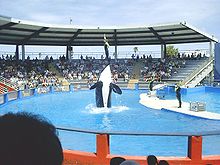Lolita (orca)

Lolita is an orca who has lived at the Miami Seaquarium for 40 years.[1]
Early life
On August 8, 1970 in Puget Sound Lolita along with seven others were caught to be sold to marine parks and aquariums. Tokitae, as she was originally named, was purchased by Seaquarium veterinarian Dr. Jesse White for about $20,000. [2] On arriving to the Seaquarium Lolita joined another Southern Resident Orca named Hugo who was captured some time before Lolita and had lived in the park two years before her arrival. At first they were housed apart so they would not fight but they were eventually put together. Tokitae was re-named Lolita “after the heroine in Vladimir Nabokov’s novel by The News.” [3]

Hugo and Lolita got along well with each other during the years they spent together but on the morning of March 4, 1980 staff arrived to find a lifeless Hugo. “We found her bumping up against Hugo’s body. It’s impossible to know what she was thinking. They were very protective of one another when one of them was sick. I’d just like to forget about that day.” recalls trainer Eimstad.[4] Hugo had suffered a brain aneurism after being lethargic for several weeks.[4][5] “We expected problems when Hugo died but Lolita preformed as usual the next day,” trainer Lou Roth recalls “Once in a while she would look for him, but she got over it.”[6] Even though the pair had bred many times (once to the point of suspending shows[4]) the two never produced any live offspring.[6]
Controversy
While Lolita is literally the Seaquarium’s biggest star she has also attracted the facility some unwelcomed attention from animal rights groups and anti-captivity activists. In 2008 Lolita was the subject of the documentary Lolita: Slave to Entertainment in which many anti-captivity activists, most notably Ric O'Barry (former Flipper trainer), argue against her current conditions and express a hope that she may be re-introduced to the wild. Protesters assert that the Seaquarium is treating Lolita cruelly by maintaining her in what they call a “concrete prison.” Mr. Arthur Hertz, owner of the park, assures that Lolita is happy in her home, gets all that she could ever need or want and is like family to him and her trainers. He points to Lolita’s apparent good health and longevity as evidence of her quality of life. “Even critics, such as research scientist Ken Balcomb, will admit the Seaquarium has done a good job meeting her nutritional needs.” [2]
References
- ^ http://www.miamiseaquarium.net
- ^ a b [1] Seattle Times Cite error: The named reference "”Seattle" was defined multiple times with different content (see the help page).
- ^ [2] The Miami News “Lolita officially named”
- ^ a b c [3] The Palm Beach Post “Whale” Cite error: The named reference "The Palm Beach Post" was defined multiple times with different content (see the help page).
- ^ [4] Youngstown Vindicator “Widowed Killer Whale Is Tame Talent in the Tank”
- ^ a b [5] Boca Raton News “Lolita: happy, gentle, smart; weighs 4 tons” Cite error: The named reference "Boca Raton News" was defined multiple times with different content (see the help page).
